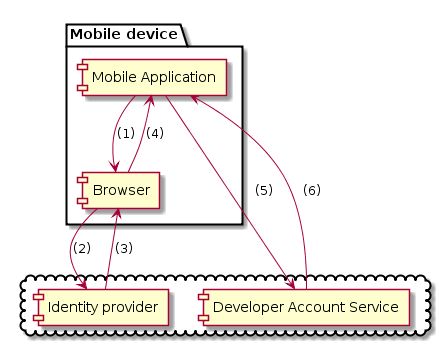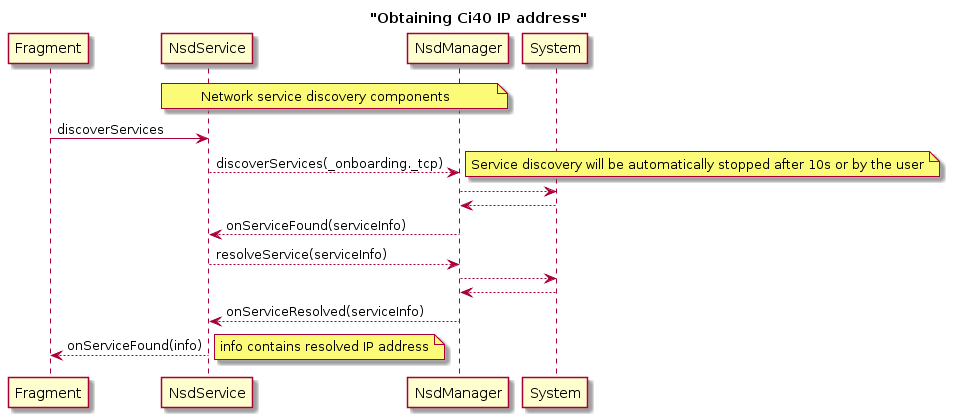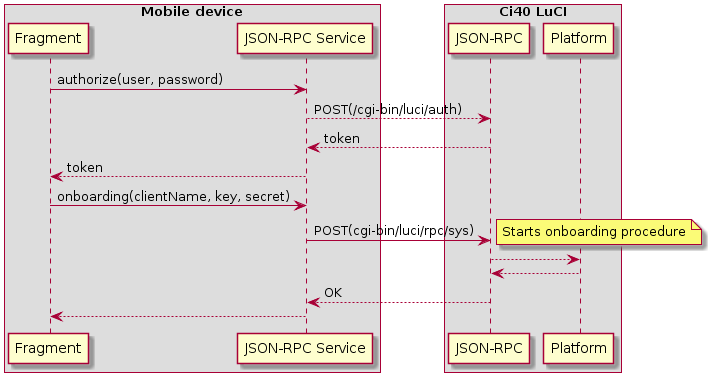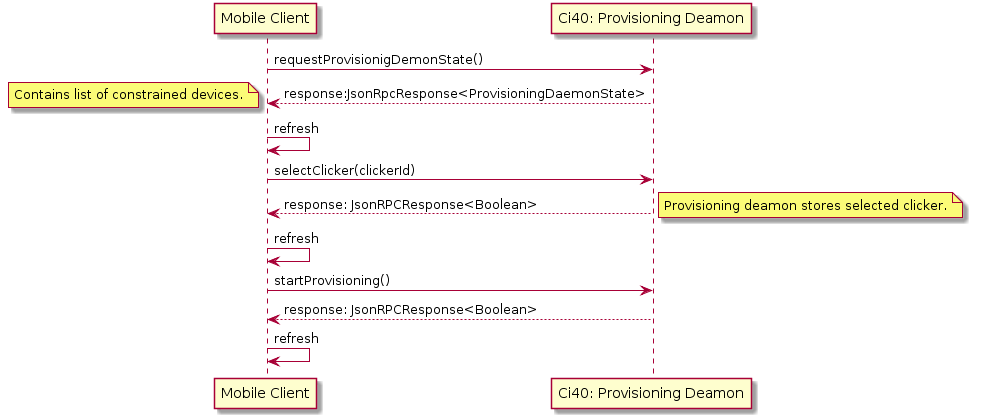This application requires Android 5.0 or above.
After importing project to Android Studio please rename 'app/gradle.properties.sample' to 'app/gradle.properties' and provide proper configuration to sign your app.
The 'Onboarding-app' is a mobile Android application that helps users to easily perform Ci40 onboarding and clickers provisioning. This gets Ci40 and constrained devices onto a network and registered with Device Server.
This Android application is one component within a bigger system consisting of Ci40 tooling (provisioning demon & scripts), constrained devices (running provisioning library) and Device Server (DS) as illustrated in the following diagram:
What this means is that using a secure communication channel, the mobile client is able to prepare Ci40 and constrained devices to interact with the Device Server.
For Ci40, the mobile application must:
- provide the configuration necessary to download and store certificates from Device Server,
- introduce Ci40 with a user-friendly client name (the board will be visible on the developer console with that name),
- provide configuration for the Awa client
This is known as the "Ci40 onboarding process".
For constrained devices the "provisioning process" requires the mobile client to:
- provide network configuration
- provide configuration to obtain a PSK from the Device Server
These components are all required by the system as a whole, and gaining some understanding of them will help to clarify the role of the mobile application.
-
provisioning demon:
- application that runs on Ci40 board,
- ensures secure connection between constrained devices,
- exchanges crypto keys and much more
- can be found [here] (https://github.com/CreatorDev/ci40-provision-daemon)
-
scripts:
- provides entry point for communication provisioning demon and LuCI web scripts
- exposes utility API available via JSON-RPC and uBus
- can be found [here] (https://github.com/CreatorDev/ci40-onboarding-scripts)
-
provisioning library:
- delivers PSK and other configuration data to provision constrained devices
- can be found here
-
device server:
- LWM2M management server,
- exposes secured REST API/HTTPs used by the mobile app
Communication with Device Server requires authentication with a user account. To acquire access keys (that will be used to obtain a Device Server access token), the user has to login first with their CreatorID (points (1)-(4) on the following diagram). Having 'token_id' from the Identity Provider (IP) client now may obtain access keys (key and secret) performing simple HTTP request (points (5) and (6)) to the 'Developer Account Service.
(1) launch system browser for signing into identity provider
(2) login/sign-up using system browser
(3) Identity Provider (IDP) issues an authorization code to the redirect URI
(4) application receives authorization intent with token_id
(5) - (6) requesting access keys
Having access keys we can easily login to Device Server and request for a list of connected clients.
To run properly following list of dependencies must installed on Ci40:
curl luci-mod-rpc libubox-lua avahi luci-ssl uhttpd-mod-tls
- Developer has account on the Device Server (you can make one on the Developer Console)
- Ci40 has configured network connection
- Ci40 is running mDNS,
- mDNS responds to search _onboarding._tcp service type
The mobile application is designed to work in the local area network. To obtain the Ci40 IP address the mobile client uses Multicast DNS service discovery. the following diagram shows this procedure:
The mobile client can now send configuration data to the Ci40. This can be achieved via LuCI through JSON-RPC API. The following sequence diagram shows this procedure.
If the 'onboarding' operation succeeds a new device should be visible on the Developer Console and on the clients list in the application.
Authorization and onboarding are two remote procedures that can be executed. In addition to these there are other methods that can:
- remove configuration
- get basic info about LuCI configuration
- check if Ci40 is configured
As previously mentioned, provisioning of constrained devices is about obtaining a PSK from the Device Server and passing it to the device.
To do that mobile client needs to communicate with constrained devices via the provisioning daemon process running on Ci40. In this context the mobile client should be treated as a controller that knows how to (via JSON-RPC):
- request a list of available constrained devices,
- select a constrained device,
- launch provisioning on selected device.
The following diagram presents this procedure:
For more information about provisioning, please read the documentation for the [provisioning daemon] (https://github.com/CreatorDev/ci40-provision-daemon) and [onboarding scripts] (https://github.com/CreatorDev/ci40-onboarding-scripts).
If you have a contribution to make please follow the processes laid out in contributor guide.





